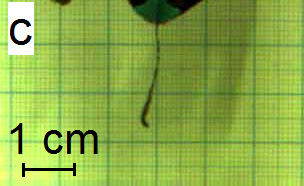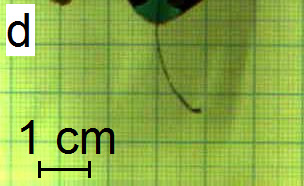Artificial Muscles
Polymeric actuators are materials that convert electrical stimuli to mechanical displacement. Conjugated polymeric actuators among all types of actuators have a unique position, due to simple and low-cost preparation, flexibility, light weight, and good mechanical properties. Owing to these features, they are considered as promising candidates for mimicking natural muscle behavior for which they are sometimes called “artificial muscles”.
Our research field focuses on ionic electroactive polymer actuators, such as polyaniline with novel morphological features. In ionic electroactive polymer actuators, migration of ions between polymeric chains due to external electric field is the principal mechanism of mechanical strain. According to specimen geometry, this strain can be converted to linear or bending mm-scale displacement.
Figures below illustrate bending of a polyaniline actuator strip in air by applying a 0.5 V potential.


Separation Membranes
In our laboratory, we design and develop smart hybrid membranes using the initiated Chemical Vapor Deposition technique for protein separation applications. For this purpose, stimuli-responsive and conductive polymer coatings are used to prepare the membranes. The effects of polymer type, membrane geometry, and coating thickness on the separation performance are investigated.
Controlled Delivery
In our laboratory, we develop stimuli-responsive and conductive polymer nanostructures for controlled delivery applications. We use model molecules to study the early time kinetics of release from the developed nanostructures. Stimulus-responsive polymers are employed to achieve a triggered response. By tuning the shape of the nanostructures and the polymer composition, release kinetics can be controlled.
Sensors
In today’s world, many diseases are accompanied by odors, which means that the detection of volatile organic compounds at high sensitivity and selectivity can make early diagnosis possible. With that motivation, conducting polymers with varying nanostructures are produced in our laboratory with predetermined properties and used as a sensing material for gases. While electron acceptor gases can remove electrons from the aromatic ring of a conducting polymer, polypyrrole, electron-donating gases have the opposite effect. This leads to a change in conductivity, and a highly sensitive detector for volatile organic compounds can be developed by monitoring the conductivity change. In addition to VOC sensors, our group is also working on developing humidity sensors using conductive polymeric nanostructures.


